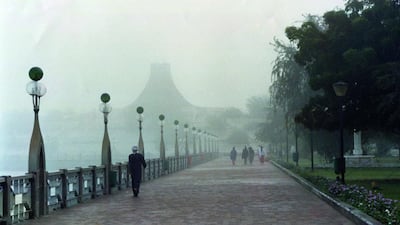Picture this. It’s 1994 and you are an inquisitive 7-year-old with little patience to spare in the emirate of Abu Dhabi, a quiet, slow-paced city where sprawling air-conditioned malls are still years away.
Where housewives swear that you can buy everything from hairpins to steel trunks at the old open-air souq on Khalifa Street. Where television sets still have antennas and catching the latest movie releases means frequently sending your parents back and forth to the local video library to check if The Lion King cassette had been returned by the previous customer.
Where you spend days creating your own VHS tapes by recording your favourite cartoon shows on TV. Rewind, record, repeat. Where mobile phones are bigger than your shoes and only used by fathers for work or “emergencies”. And research for school projects means thumbing through a 12-volume encyclopaedia set.
A time warp where there is no internet. Not even dial-up. And certainly no data connection. Evenings are spent playing with friends and cousins in the local parks, yelling to be pushed higher on the swings and pushing each other around on the slides.
There are no 80-storey towers to give you a panoramic view of the city and the Corniche. And giving directions is based on informal names of buildings, streets and landmarks that people have come to accept instead of street numbers. And then there is the Volcano Fountain.
Now picture this. You’re at the intersection of Khalifa Street and Muroor looking towards the Corniche. The sun has just set and the humidity is rising. A slight breeze blows your way from the sea. The white and gold taxis zip past you blaring their horns as the drivers make their way to the mosque for evening prayers. And right there in front of you, just a few metres away, is a giant pyramid-shaped structure spewing “lava”.
As evening transitions to night, the fountain transforms into a fiery red inferno that seems to tower over you as you draw closer. There are people scattered around the structure. Some are on their evening walk, while others are taking pictures with the fountain in the background. You are tempted to touch the “lava”, but it’s still quite a trek to the summit.
The fountain is perched atop five tiered circular platforms. There are men at its base hawking peanuts roasted in metal woks placed in cardboard boxes filled with hot charcoal and sand. If you pay a dirham, you can buy more than a handful, which will be served to you in narrow tapered cones made out of newspaper.
Farther ahead you can see vendors serving Pepsi, Kwality and Igloo ice creams to children from big coolers on wheels. With a cone of roasted peanuts in one hand and an ice cream in the other, you approach the stairs and make your way up the first tier. Each tier is surrounded by white metal fencing, and there are shrubs and flowering plants neatly planted in rows along the circumference.
By the time you reach the second tier, you’re tired and look beseechingly at your father, who carries you up the rest of the way. When he sets you down next to the fountain, you allow yourself the luxury of following the water with your gaze as it leaps forth from the peak and cascades down the slopes to the bottom, the lights changing the hue of the water every few minutes.
You circle the fountain, dipping your hands into the water, and take in the magnificence of it all. You look around and Abu Dhabi city stretches before you on one side while the Corniche, outlined by the lamp posts’ glittering orbs, disappears into the darkness on the other end. You close your eyes and breathe in the smell of the sea mixed with the earthy aroma of freshly roasted peanuts. You hear the roar of the water as it circulates through the fountain. You hand what’s left of the peanuts and ice cream to your parents and proceed to run down the steps in a mock race with your brother, not looking back till you reach the bottom. You place your hand on the white fence and swing silently as you wait for your parents, gazing every now and then at the fountain, its roar still resounding in your ears.
It’s a long walk back home to Hamdan Street, or at least it seems that way, for a 7-year-old, and the fountain is already a distant memory. You don’t think twice about it because, after all, it’s always going to be right where you left it. Even as you pass it every day on your way to school or on the way to your best friend’s house for a party, you don’t pay attention to it, but you know it’s right there. Standing vigil over the Corniche and the city.
Until one day it’s no longer where you left it. All that’s left of the towering structure is a giant mound of sand that peeps over blue construction boards. New memories are planted in the spacious green parks that take its place, and the city gradually replaces one beloved space with another.
The fountain hasn’t disappeared entirely, though. It springs back to life when you find that old faded photograph of you posing awkwardly in front of it and you can almost feel the spray from the fountain wetting the back of your head and clothes. Or when you meet someone who grew up in Abu Dhabi and you collectively reminisce about the many evenings that were spent near it. Every now and then you rebuild the fountain bit by bit from snatches of memories, personal and borrowed, till it feels like that 80-foot inferno is right there in front of you, waiting for you to climb those stairs once again, just like you did when you were 7 years old.

